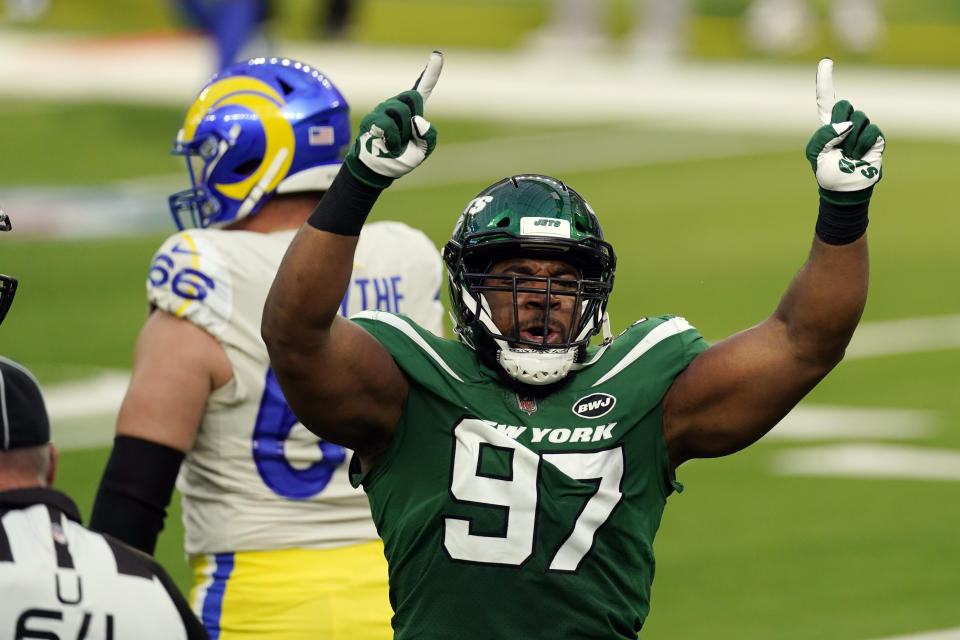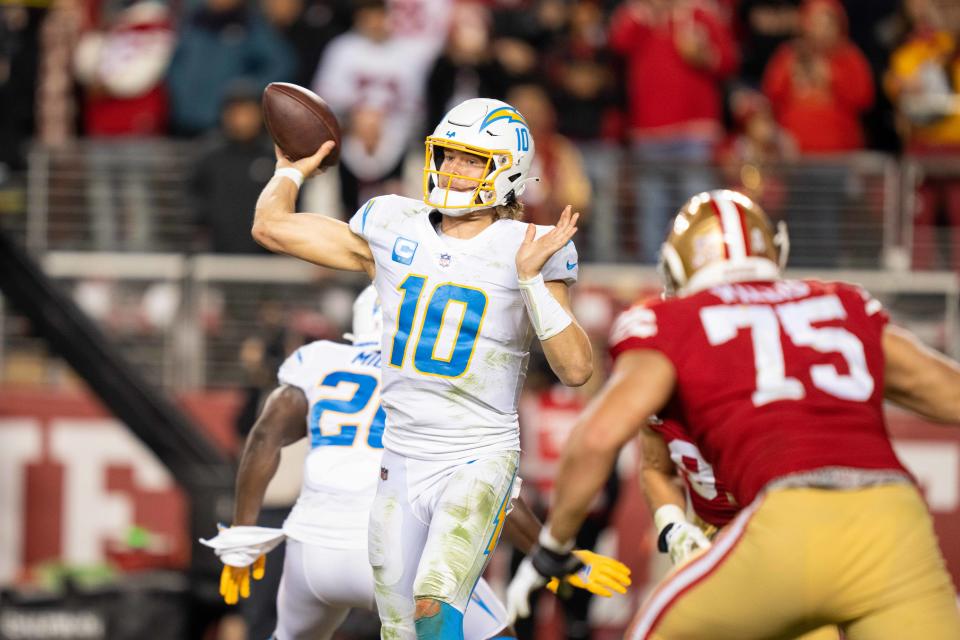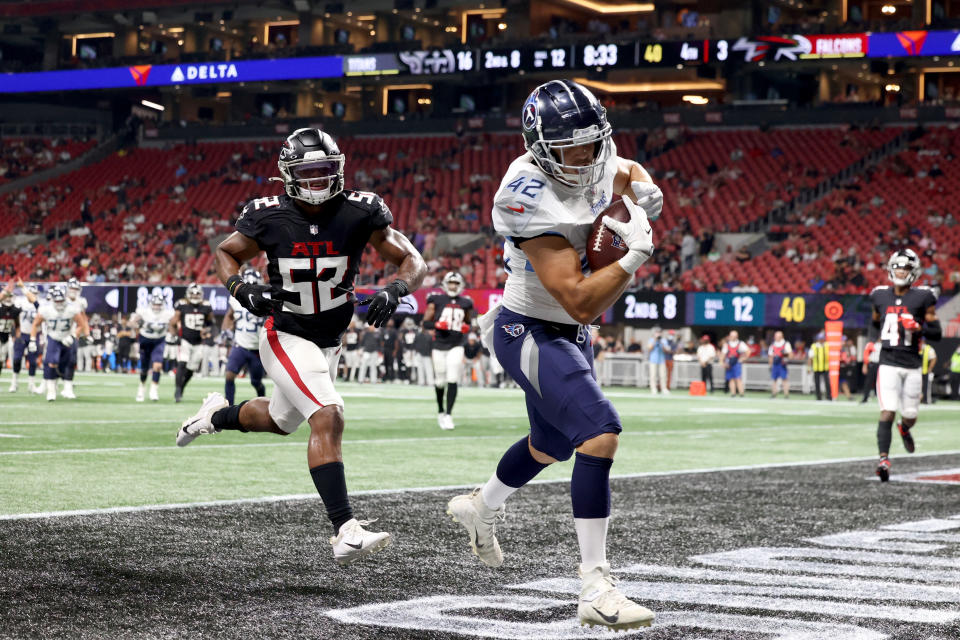How the NFL could expand to an 18-game regular season

Sports are entertainment, so the product should be entertaining, right? It’s unfortunate that so many small things that made the NFL special have fallen by the wayside — particularly rivalry games. It’s something currently being eroded at the college level as super-conferences and realignment sprint towards an event horizon, a point of no return.
Let’s acknowledge the elephant in the room: at some point in the future the NFL is going to roll out an 18-game regular season, just like it expanded to 17 from 16, and from 14 before that. League ownership has profited wildly from the expanded regular season and the lucrative media rights contracts that come with it, and they’ll go back to that well sooner or later.
Players and coaches have already talked about the workload that adding just one more game to the established 16-game slate caused. Adding a second one without any other changes will only make it worse. So how could it be done in a way that doesn’t diminish the product? Here’s our proposal, and for the sake of illustrating each point, how each change could impact the New Orleans Saints:
Adding a second bye week
This is a must. The way things work right now, the only way a team would get a second bye week is by winning the top playoff seed in their conference — a competitive advantage that has often helped the top-seeded teams reach the Super Bowl with more time to rest and heal up before the conference title game. Leveling the playing-field by introducing two bye weeks during the regular season would go a long way to helping players refresh and stay healthy over the course of a long season.
They shouldn’t be randomly spaced apart, though. Instead we’re proposing a seven-week stretch between each bye week, beginning in Weeks 5, 6, 7, or 8 of what would become a 20-week regular season. This way every team either starts the year with at least four games before their first break or ends it with four or more games to play.
Here’s what it would look like:
Weeks 5 and 13
Weeks 6 and 14
Weeks 7 and 15
Weeks 8 and 16
Of course this runs the risk of having too many teams on bye to handle a full week of games. Our response to that is eight teams (four games’ worth) would go on bye at the same time, leaving 24 teams (twelve games’ worth) still in play. That’s enough for the prime-time matchups on Thursday, Sunday, and Monday nights as well as five or six early-afternoon broadcasts and three or four late-afternoon games, with the flexibility for early-morning international kickoffs and double-headers. And there would still be 12 weeks in which all 32 teams are active.
Cutting down the preseason
Adding a second bye week is only one step here. There’s some fat that can be trimmed off the schedule in other areas, specifically the preseason. These exhibition games are poorly-attended (Seriously, why all the empty stadium seating? Donate unpurchased preseason tickets to the local Boys & Girls Club) dress rehearsals that frankly don’t mean much — there’s always a lot of buzz over how they can be make-or-break opportunities for guys on the roster bubble, but those decisions are usually made after weeks of practice in training camp, rather than being based off of just a couple of quarters at half-speed in an exhibition game.
The NFL has already cut the preseason down to three games from four. Reducing it further to two games from three would be fine. That’s still plenty of time for teams to trot out their starting lineups (if they choose to do so at all) and evaluate players on the fringe in different situations. If we were really focused on making these games into evaluation opportunities, they’d be canceled altogether and replaced by intersquad scrimmages organized by both teams’ coaching staffs. There’s a reason that joint practices are growing in popularity by the year.
Moving the Super Bowl to Presidents' Day Weekend
Now here’s a popular request, and we’ve done it. Whenever NFL schedule changes are discussed, the idea of moving Super Bowl Sunday to Presidents’ Day Weekend always seems to come up. Presidents’ Day (established to celebrate the birthday of George Washington on Feb. 22, and often included to celebrate Abraham Lincoln’s birthday on Feb. 12) always takes place on the third Monday in February, so this would be stable from one year to the next.
By eliminating the third preseason game and moving Week 1 up a week sooner while adding a second bye week and another regular season game, we’ve laid out a scenario where the Super Bowl would precede Presidents’ Day. In 2024, Presidents’ Day falls on Feb. 19. Super Bowl LVIII will be played on Feb. 11. Moving it with our schedule tweaks puts it on Feb. 18 and give many fans the following Monday off to recover from the festivities during what’s already a national holiday. How’s that for a happy coincidence?
Other changes and suggestions
Of course there needs to be more changes while expanding the regular season. Rosters need to get bigger to accommodate more injuries. Practice squad elevations have already taken off well, but they’re still too restrictive to be as helpful as they could be on a week-to-week basis. League ownership is miserly when it comes to setting those salaries and determining how many players can be active on game days, so odds are it’ll take people with more skin in the game than you or me to cut a deal. For now we’ll just acknowledge it needs to change.
The annual NFL trade deadline is something we’ve talked about before. It’s in an awkward spot after Week 8, meaning a lot of teams still don’t know where they stand — a 4-4 team could hope to turn things around, while a 3-5 outfit is still talking itself into a second-half comeback. Pushing the trade deadline back to Week 10 would dramatically separate the haves from the have-nots and prompt some teams into shifting gears to load up on draft picks and future assets. A 3-7 or 4-6 team is probably more eager to trade away its players.
Now, about those permanent non-conference rivals
So how do you get to 18 regular season games? The NFL’s solution for a 17th game was actually very clever — they made the rare AFC-NFC matchups more frequent by adding a same-place finisher in another division each year. It’s why the Saints played the Tennessee Titans in 2020, the New England Patriots in 2021, and the Las Vegas Raiders in 2022. Otherwise those are teams they only see once every four years, barring a Super Bowl bout.
It’s a thread we should keep chasing. Adding another regular season game shouldn’t mean a random matchup. These games need to have some kind of purpose, so we’re looking to undo some of the league’s past missteps and missed opportunities. That means reestablishing past rivalries that were lost in expansion (like the Seattle Seahawks leaving the old AFC West) or the NFL’s own shortsighted meddling (which ended the very fun Cleveland Browns-Detroit Lions preseason series). We’re not just pairing rare opponents together more often. We’re rebuilding some of the sense of community that’s been lost over the years — while, yes, blatantly chasing more revenue.
We’re talking about non-conference permanent rivals, preferably with some history to build off of or natural geography that makes them good fits. Travel time was also a consideration, though in at least one rivalry series it was unavoidable (and we can already see Roger Goodell trying to spin it as a positive), with data sourced from Google Maps.
On average, these matchups call for flight times of 98 minutes with a median time of 75 minutes between host cities. The teams involved have played each other 18 times on average, with a median length of 14-game series. Obviously airport security and wait times are going to stretch that travel time further, but it’s very manageable for most fanbases.
The 17th game is already played on a rotation where the NFC hosts in even-numbered years while the AFC hosts during odd-numbered years. We’ll swap that for the 18th game between non-conference rivals so that every team is guaranteed nine home games each season (barring international games and emergency relocations, of course). That’s going to make a lot of home fans very happy.
Because the two rival teams could still be scheduled to play through the normal formula, either due to the four-year divisional rotations or the three-year same-place standings, in those instances the team would play the same-place finisher from whichever division they saw a year prior.
Here’s an illustration (spoiler alert: for this exercise, the Saints’ non-conference rival is the Houston Texans) showing what it would look like if this were implemented in 2023 (which it won’t be):
Regularly scheduled four-year opponents: AFC South teams (at Texans, Colts and vs. Jaguars, Titans)
Regularly scheduled three-year opponents (17th game): AFC East same-place finisher (at New England Patriots)
Alternative to non-conference rival (18th game): AFC North same-place finisher (vs. Pittsburgh Steelers)
Because it’s an odd-numbered year, the Saints would be hosting the Steelers after visiting Pittsburgh last season. We’re still getting more AFC-NFC games, which was the goal, and that recency can add a little juice to what may otherwise be a forgettable game. They’re still playing the Texans as regularly scheduled but would otherwise see them as that non-conference rival. There may be instances where scheduling quirks mean the Saints have to go to Houston two years in a row, but generally speaking we would expect it to be a typical home-and-away rotation from one season to the next.
Okay, all the boring logistics talk is behind us. Now the fun part: here’s our pick for every permanent non-conference rivalry.
New Orleans Saints vs. Houston Texans

AP Photo/David J. Phillip
Distance: 60 minutes
Past games: 5 meetings
The Saints haven’t seen the former expansion-team Texans very often over the years despite being a quick hour’s flight away in Houston, but there’s already a solid geographic relationship developing here between the short travel time and family connections; many New Orleanians evacuated to Houston after Hurricane Katrina, some of them putting down roots. This could take off quickly into a heated rivalry.
Jacksonville Jaguars vs. Carolina Panthers

Streeter Lecka/Getty Images
Distance: 85 minutes
Past games: 7 meetings
It’s a quick trip between these two Southern cities on the lower Atlantic Coast, and the marketing writes itself with a couple of big cat-themed mascots. If Bryce Young can perform as advertised and Trevor Lawrence continues to improve, this would be a dynamic quarterback rivalry for years to come.
Baltimore Ravens vs. Washington Commanders

Tommy Gilligan-USA TODAY Sports
Distance: 68 minutes
Past games: 7 meetings
Here’s a great in-state rivalry — you don’t even need to fly from Baltimore to FedEx Field in Landover, Md. Despite that, these two teams have only played each other seven times, so let’s get them paired up more frequently. If nothing else their two color schemes are an ideal on-field look. Competent management for Washington could make it a competitive series.
Denver Broncos vs. Arizona Cardinals

Ron Chenoy-USA TODAY Sports
Distance: 110 minutes
Past games: 12 meetings
This is one of the longer travel times we came up with in this exercise, but there aren’t many options to work with out west, so this is what we’ve got. Sean Payton getting heavily courted by the Cardinals only to end up coaching the Broncos would immediately add to some intrigue for what’s otherwise a very forgettable Arizona team.
Kansas City Chiefs vs. Minnesota Vikings

Jamie Squire/Getty Images
Distance: 80 minutes
Past games: 12 meetings
Now this could be fun. You’ve got a perennial Super Bowl favorite against one of the few actively-successful NFC playoff teams, and they’re surprisingly closely-placed in the Midwest. This could take off as one of the most entertaining rivalries around, especially if the Vikings regress and Saints fans can enjoy some schadenfreude at their expense.
Miami Dolphins vs. Tampa Bay Buccaneers

Kim Klement-USA TODAY Sports
Distance: 55 minutes
Past games: 12 meetings
This one’s easy: two South Florida teams with nothing to lose and beautiful weather year-round. It’s just a shame Tom Brady isn’t around anymore to play against the Dolphins team that hurt itself trying to tamper with him.
New England Patriots vs. New York Giants

Brian Fluharty-USA TODAY Sports
Distance: 70 minutes
Past games: 13 meetings
If there’s a consolation prize for Patriots fans, it’s that eventually the 18-1 jokes would start to grow stale. They’re already tired of shouting 28-3 from the rooftops, right? Right?
Cincinnati Bengals vs. Green Bay Packers

Albert Cesare / The Enquirer / USA TODAY NETWORK
Distance: 80 minutes
Past games: 14 meetings
These two teams are kind of awkwardly-positioned relative to anyone else, so they actually made for an easy pairing. Two unique uniform sets would easily catch the eye, even if a lot of fans would be traveling through Milwaukee on the way to and from Green Bay.
Buffalo Bills vs. Philadelphia Eagles

Mark Konezny-USA TODAY Sports
Distance: 75 minutes
Past games: 14 meetings
We’ve got two rambunctious fanbases supporting a couple of teams with plenty of star power. What’s not to love?
New York Jets vs. Los Angeles Rams

AP Photo/Ashley Landis
Distance: 350 minutes
Past games: 15 meetings
Remember how we mentioned all but one of these matchups made sense geographically? We just ran out of other options, and Jets-Giants was too obvious (as is Rams-Chargers). Asking fans to make a cross-country flight would be difficult, but it’s been done before, and the NFL’s spin doctors would put out a master class while talking up this game as an East Coast vs. West Coast affair tying the whole nation together, or something ridiculous. With that said, it would make much more sense to formalize the Subway Series here and introduce a Battle for L.A. to put both cities’ opposing fanbases at ease, though it would require shuffling some other matchups around.
Los Angeles Chargers vs. San Francisco 49ers

Kyle Terada-USA TODAY Sports
Distance: 75 minutes
Past games: 15 meetings
This could quickly devolve into the Battle Between Bosa Brothers, but maybe it won’t. Imagine the trash talk if the Chargers beat the 49ers more often than the Rams?
Tennessee Titans vs. Atlanta Falcons

Jason Getz-USA TODAY Sports
Distance: 55 minutes
Past games: 15 meetings
This one makes a lot of sense, pitting two of the South’s great cities together in an annual series. If both teams are playing well and keeping the bandwagon Falcons fans entertained, it could eventually take on the energy of a storied SEC rivalry. The Titans would also make sense as rivals for the Saints if we want to slot Houston in elsewhere.
Cleveland Browns vs. Detroit Lions

Raj Mehta-USA TODAY Sports
Distance: 20 minutes
Past games: 21 meetings
Look, we’re cheating by saying a private flight would only take 20 minutes, because the vast majority of fans would spend hours driving around Lake Erie to get from Detroit to Cleveland. But this was a well-attended, lively preseason rivalry game for years, complete with a ridiculously unwieldy trophy, and it’s a shame these two teams don’t play each other more often. Bring it back, one way or another.
Pittsburgh Steelers vs. Dallas Cowboys

Tim Heitman-USA TODAY Sports
Distance: 170 minutes
Past games: 30 meetings
This game requires a longer hike than most, but it’s worth it. It’s got it all. Iconic, storied franchises with timeless uniforms, big personalities, and devoted fans who somehow both overrate and criticize every single player on their roster. There’s a lot of history here and it would be a big missed opportunity to not shine more light on it, even if it may make more sense to have Dallas and Houston pair off for the old Governor’s Cup trophy.
Indianapolis Colts vs. Chicago Bears

AP Photo/David J. Phillip
Distance: 65 minutes
Past games: 43 meetings
The Colts inherited a lot of old-school matchups from when their franchise was based in Baltimore, but the fact remains that these are two classic teams with a shared history and plenty to play for in a Midwestern rivalry series between two major cities.
Las Vegas Raiders vs. Seattle Seahawks

Orlando Ramirez-USA TODAY Sports
Distance: 145 minutes
Past games: 54 meetings
Look, it takes forever to get anywhere from Seattle. And it made too much sense to pair them up with one of their old AFC West rivals for it to not be the pick here. If there’s one rabid, passionate fanbase that will travel anywhere, it’s the Raiders, and this would immediately make for one of the most energetic rivalry games around the league.
Conclusion
Yeah, none of this is probably happening. The NFL will eventually bully the players’ union into accepting an 18th game, with or without a second bye week, as they march towards that market saturation we talked about earlier. With the success of spring leagues like the XFL and USFL pro football is going to become a year-round sport. But the NFL is still king, and they’ll take action to maintain that status even as challengers emerge from lower levels of competition. Hopefully when the time comes to expand again they’ll put more thought and care into it than we did for this exercise.

